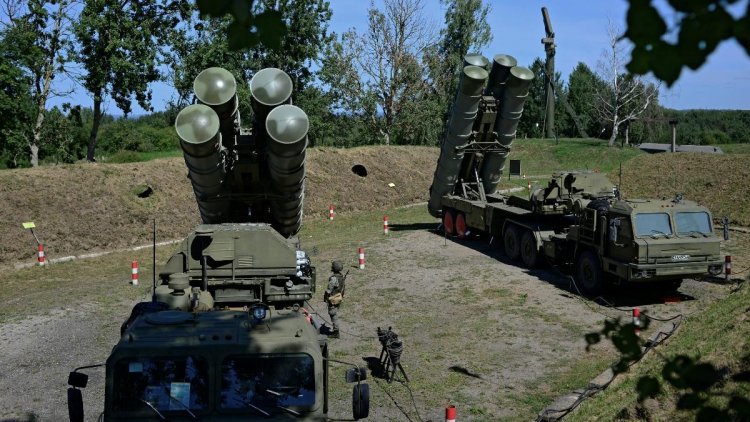India - Russia: Dependence on Russian Defence Equipment
STORIES, ANALYSES, EXPERT VIEWS

India’s ‘neutrality’ and ‘abstention’ willy nilly, is driving India closer to Russia. PM Modi has so far resisted pressure for the US and Europe to take sides. The Prime Minister made this clear even in the virtual Quad meeting Thursday. The reasons are not far to seek - India’s dependence on Russian military hardware. But there will be consequences for this approach that may drive India out of the US security orbit. For the US, the choice will be to choose who is is its bigger security threat - Russia or China.
Should India be forced to take a position against Russia, Rahul Bedi (Senior journalist) writes India could face a “nightmarish situation that will necessitate its military replacing some 50 per cent of its Soviet-era and Russian-origin platforms for all the three services, assorted other hardware, missile systems and varied ordnance with local or imported equivalents.”
Russian materiel awaiting delivery to India
For example, the more immediate crisis surrounds “diverse Russian materiel awaiting delivery to India, for which substantial payments had already been made, alongside continually needed spares and components for the in-service kit to keep the military adequately operational. These included four of the five Almaz-Antey S-400 Triumf self-propelled surface-to-air (SAM) missile systems, four Admiral Grigorovich Project 1135.6M frigates, leasing of one more Project 971 ‘Akula’(Schuka-B)-class nuclear-powered submarine (SSN) and providing 20,000 Kalashnikov AK-203 7.62x39 mm assault rifles, which were a part of the deal signed last December to locally licence-build 601,427 of them.
“Additionally, India had recently concluded assorted deals with Russia to provide it diverse missiles, including man-portable Very Short Range Defence Systems (VSHORADS), tank ammunition and ordnance, much of it for employment by the Indian Army, which is locked in a continuing faceoff with China’s People’s Liberation Army in Ladakh since May 2020.”
Larger impact of sanctions
Jeopardise BrahMos cruise missile export order from the Philippines: But more critically, writes Bedi “the US and European sanctions on Russia could conceivably jeopardise India’s recent $375-million BrahMos cruise missile export order from the Philippines. Industry officials deemed this more than likely, as Russia’s NPO Mashinostroyenia (NPOM) that constituted the joint venture with India’s Defence Research and Development Organisation to design, upgrade and manufacture BrahMos was responsible for providing the missile system’s engine and seekers. NPOM’s inability to provide these vital components due to sanctions would threaten India’s first major overseas contract aimed at officially boosting materiel exports five-fold to Rs 35,000 crore by 2025.
T-90MS main battle tanks: “India was also in advanced discussions with Russia to procure 464 Russian T-90MS main battle tanks (MBTs), an undisclosed number of 2S25 Sprut-SD light tanks for employment in Ladakh and 12 Sukhoi Su-30MKIs — to be licence-built locally — besides several other items. All are collectively imperilled now by the sanctions.”
Air Force' dependence
An inventory of the Russian defence employed by India’s military, writes Bedi “reveals the immense and unimaginable magnitude of the task in seeking substitutes. The Indian Air Force’s 29 or 30 combat squadrons, for instance, comprise some 272 Su-30MKIs, over 100 MiG-21 ‘Bis’ ground attack fighters, around 60 MiG-29 air superiority platforms and 220-odd Mi-17 ‘Hip’ variant medium-lift helicopters.
Navy’s dependence
“The Indian Navy’s principal warships were predominantly Russian in origin and design, or both. Topping this list was INS Vikramaditya (ex-Admiral Gorshkov), the retrofitted 44,500-tonne Kiev-class aircraft carrier and its air arm of 16 MiG-29K/KuB fighters. Concurrently, another 29 MiG-29Ks will comprise the combat fleet of INS Vikrant, the indigenously developed 37,500-tonne carrier, presently undergoing sea trials and scheduled for commissioning in August to mark India’s 75th Independence Day anniversary.
“The Navy also operated six Talwar-class frigates, in addition to another four advanced variants on order, while its underwater platforms included nine ‘Kilo’-class Type 877 diesel-electric submarines of a total of 16 boats. Russia had also provided the DRDO vital assistance in designing INS Arihant, the Navy’s first indigenously designed and built nuclear-powered ballistic missile submarine (SSBN) that joined service surreptitiously in August 2016.
“Russia is also presently involved in transferring knowhow to miniaturise the 82.5-MW reactor for the four or five follow-on SSBNs, presently under construction at the classified Ship Building Centre in Vishakhapatnam.”
No other country, underscores Bedi “has been willing to make such strategic technology transfers to India, but sanctions would most definitely thwart Moscow’s ability to continue doing so…”
Army’s dependence
“Furthermore, over 95 per cent of the Army’s fleet of around 3,000 MBTs operated by 67-odd armoured regiments were Russian T-72M1 and T-90S variants — imported directly and licence-built — whilst some 2,000-odd infantry combat vehicles or ICVs — the Boyevaya Mashina Pekhoty (BMP) 1& 2 — were similarly sourced.”
Ukrainian contracts
The conflict has also hit a “multiplicity of Ukrainian contracts, like the upgrade of around 60 IAF Antonov An-32 ‘Cline’ transport aircraft, the supply of critical R-27 air-to-air missiles for Su-30MKIs and the transfer of eight Zorya-Mashproekt M7N1EW gas turbines to power the Navy’s four under-construction Talwar-class frigates. Two of these were being built at Russia’s Yantar Shipyard and two at Goa Shipyard Limited (GSL), under a transfer of technology pact. The Ukrainian engines for the former two warships had reportedly been transferred to Russia, but not the ones intended for GSL."
















